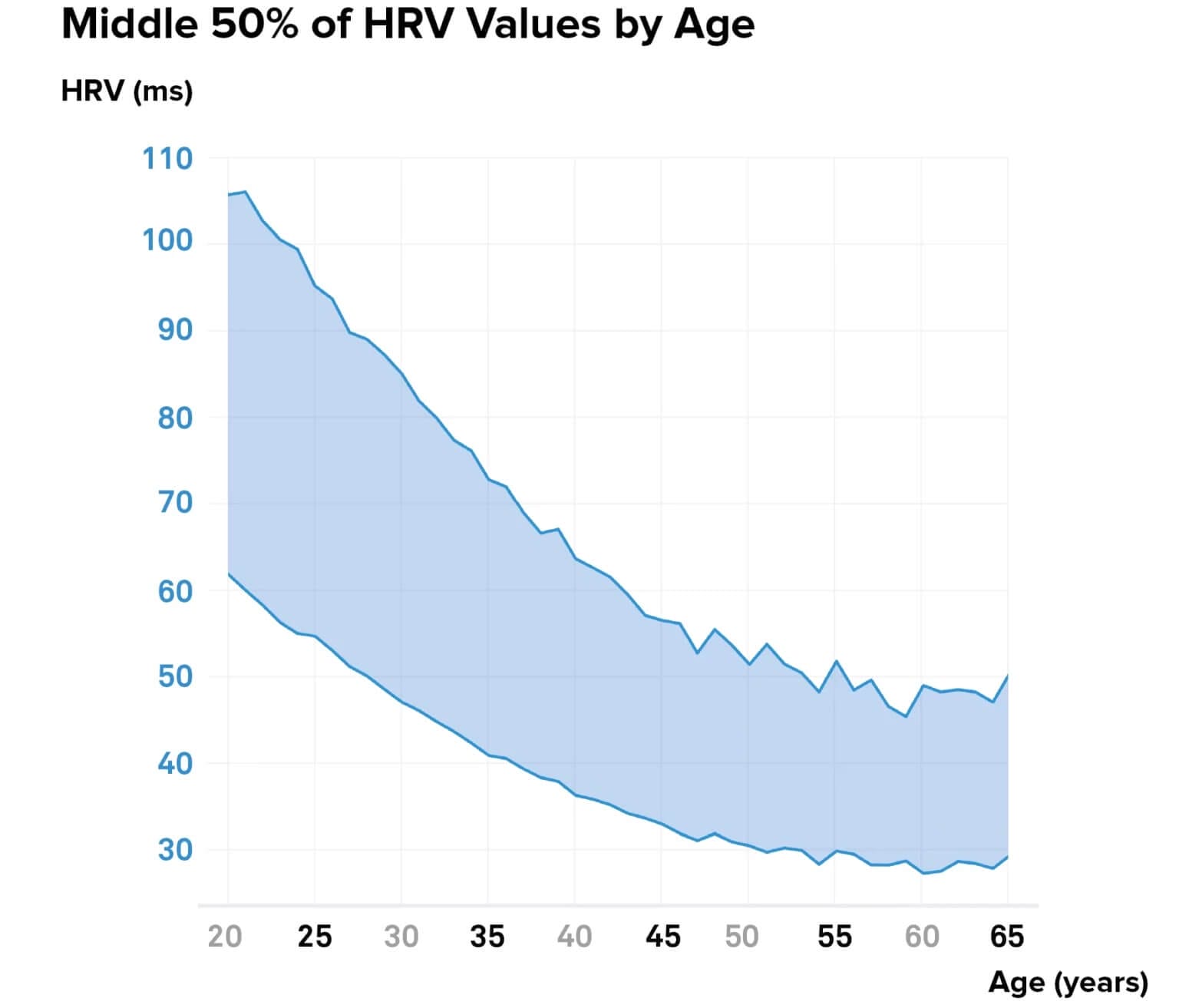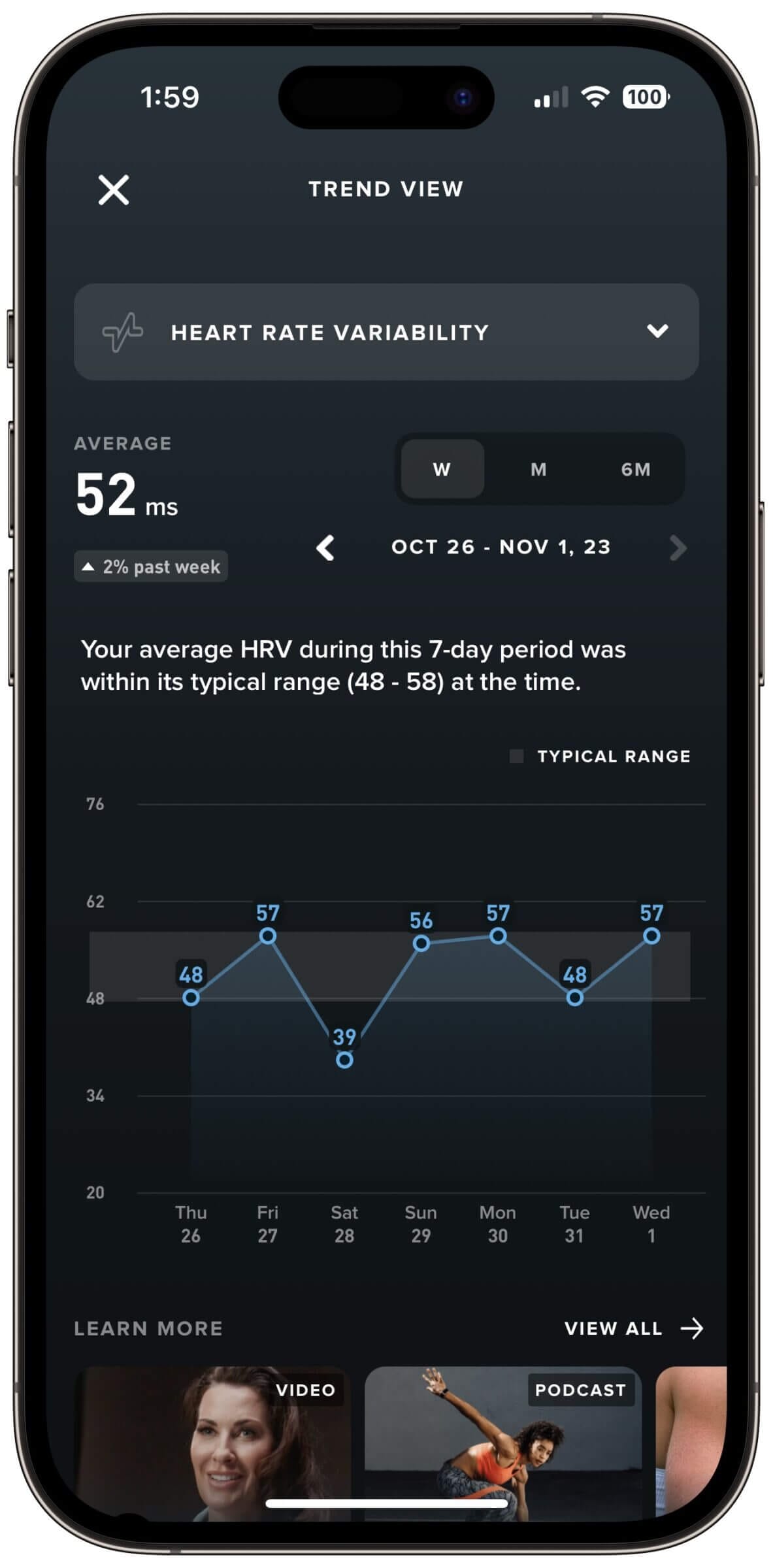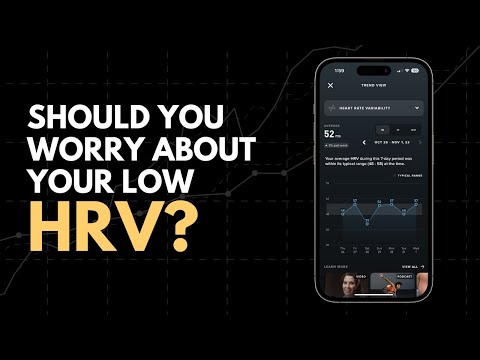People are constantly asking me what a good HRV is. Unfortunately, there is no single (or simple) answer to that question, because HRV is a highly individual metric that depends on factors like age, sex and overall health.
But in this article, I’ll explain how to judge whether or not your heart rate variability falls within a normal range, outline the mistakes you should avoid when measuring your HRV (to ensure you obtain relevant data), and highlight tools you can use to get more actionable readings.
Before we dive into the nitty-gritty, here are the most important aspects you should consider for interpreting the variability between your heart beats (aka your HRV):
- Based on statistics from wearable trackers such as WHOOP that monitor HRV, the average HRV (across all age ranges) is 65 for men and 62 for women. I’m a 42-year-old male in excellent overall health and cardiovascular fitness, and my typical HRV hovers between 55 and 64 ms.
- HRV appears to decline significantly with age.
- Higher HRV values are often incorrectly associated with better cardiovascular health (and vice versa). The truth is much more complicated. So don’t freak out if your HRV numbers are lower than someone else’s.
- Super high HRV readings (300 ms or higher) can be a sign of a heart condition.
- Your HRV is constantly in flux, so the best time to measure it (and to get relevant data) is when you’re completely calm and free of external inputs (i.e., during deep sleep).
- Monitoring HRV trends is much more important than individual readings.
- There are plenty of things you can do to improve your HRV.
The bottom line is that HRV readings can be all over the place and are influenced by countless factors, including your age, fitness level, gender, measuring methods, time of measurement, lifestyle, environment and genetics.
The single most important aspect of using HRV as a tool to improve your health and well-being is not to stress out about it, because stress is a surefire way to activate the sympathetic branch of your nervous system, leading to lower HRV readings.
What Is HRV and Why Does It Matter?

Heart rate variability is the difference in timing between heart beats. It’s a noninvasive method used to assess the autonomic nervous system (ANS). Specifically, a low HRV indicates a dominant sympathetic nervous system (which is what puts you into “fight or flight” mode), while a high HRV indicates a dominant parasympathetic nervous system (which is responsible for “resting and digesting”).
Technically, HRV is measured in milliseconds and expressed as RMSSD (the root mean square of successive R-R intervals).
A well-balanced nervous system is associated with better overall health, a healthy heart, and a lower risk of developing a cardiovascular disease. In contrast, reduced HRV is associated with adverse cardiovascular outcomes and mortality.
That’s why so many healthy living enthusiasts are so focused on increasing HRV.
What Is a Good HRV Range?

As I mentioned above, HRV can vary significantly due to factors including age and gender. However, below are average HRV values based on data reported by studies such as the Baependi Heart Study.
Age Group: 20-25 years
- Men: 55-105 ms
- Women: 55-105 ms
Age Group: 25-35 years
- Men: 50-90 ms
- Women: 50-90 ms
Age Group: 35-45 years
- Men: 45-85 ms
- Women: 45-80 ms
Age Group: 45-55 years
- Men: 40-75 ms
- Women: 40-70 ms
Age Group: 55-65 years
- Men: 35-70 ms
- Women: 35-65 ms
Age Group: 65+ years
- Men: 30-65 ms
- Women: 30-60 ms
As you can see, HRV declines dramatically with age. One study I read concluded that, “although the aging process is associated with a decrease in HRV measures, some findings suggest that a decrease in HRV depends on the preservation of autonomic function, especially in the HRV-parasympathetic arm, instead of an age-related decrease.”
In other words, it’s not aging that lowers your HRV, but rather your inability to preserve your autonomic function.
While it’s still unclear how aging modulates autonomic function, there are several methods you can leverage to improve it, including the ones I mention in my article about how I increased my HRV by 50%.
What to Do If Your HRV Is Low
If you’ve found this article because your HRV numbers are lower than you expected, the most important thing to do is avoid freaking out.
That’s because stress activates the sympathetic branch of your nervous system and lowers your HRV.
In other words, stressing out about low HRV is 100% counter-productive.
Instead, I recommend assessing the following factors to see if one or more of them could be causing lower-than-expected HRV readings:
- HRV measurement method. Are you using the right tools to accurately obtain meaningful HRV readings?
- HRV measurement time. Did you measure your HRV without being exposed to external influences that could lead to inaccurate readings?
- How well are you managing chronic stress?
- Are you overtraining by exercising too much without giving your body enough time for recovery?
- Are you consuming an appropriate diet centered around nutrient-dense foods?
- Are you getting enough (quality) sleep each night?
- Are you physically active and fit?
- Are you metabolically healthy?
- Do you regularly consume alcohol, or use tobacco products or recreational drugs?
- Are you on hormone replacement therapy?
- Do you suffer from high blood pressure?
- Are you hydrating enough?
Addressing these factors can significantly improve your HRV.
How and When to Measure HRV (to Obtain Relevant Data)

Your HRV is constantly in flux, making it difficult to interpret the numbers. That’s why it’s crucial to measure HRV at times when you’re not influenced by environmental factors.
One of the best ways to avoid external influences is to measure HRV during deep sleep, when your brain is more or less disconnected from its environment. That’s why wearable devices such as WHOOP and Oura Ring measure HRV at night, while you’re in deep sleep.
Of course, that means whatever device you choose for measuring HRV has to be able to reliably detect when you’re in deep sleep. The good news is that both WHOOP and Oura Ring do a fairly good job at sleep stage tracking, leading to relatively actionable HRV readings.
You can learn more about how each device works in my WHOOP 4.0 review and my WHOOP vs. Oura Ring comparison article.
If you don’t have a sleep tracker that measures HRV during deep sleep, you can also use apps such as EliteHRV to measure your HRV in the morning when you’re calm, with a low heart rate and without distractions. Doing so might be slightly less accurate than measuring HRV during sleep, but I consider it good enough to monitor your HRV trend.
Lifestyle Factors That Influence HRV

If you have ruled out measurement errors and are still seeing low HRV levels, it’s time to examine your lifestyle choices to see if they’re the culprit.
Some of the most obvious factors that can lead to low HRV readings include chronic stress, alcohol consumption, poor sleep and overtraining.
For reference, if I consume as little as one glass of wine, I see an immediate drop in my HRV (and an increase in my resting heart rate) the following night. If I consume more than one serving of alcohol, I often see low HRV numbers multiple nights in a row. So if you consume a glass of wine every night with dinner, you’ll likely chronically suppress your HRV.
Keep in mind that HRV is an indirect indication of how your nervous system is responding to elevated stress levels, including classic stressors such as problems at work and parenting, but also poor diet, poor sleep and hormetic stimuli such as regular exercise, sauna bathing, fasting and cold plunging.
All of those factors can influence your autonomic nervous system and dictate how much time your body spends in fight or flight mode vs. rest and digest mode.
In the realm of HRV, exercise can be a double-edged sword. If you’re not fit, your cardiovascular system may get stressed by otherwise benign physical activity such as walking up and down the stairs. That can lead to lower HRV readings as your body is trying to recover from those “stressors.” That’s why it’s important to maintain optimal fitness, so that regular daily activities don’t stress your body too much.
It’s also vital to push your body to its limits from time to time, so you can improve your fitness and stress resilience. However, what many fitness enthusiasts overlook is the importance of rest to allow your body to recover.
Case in point: I’m almost 42 years old, but I’m the fittest I’ve ever been in my entire life (despite having been a professional athlete in my early 20s). I’m active every day, but I only push my body (as part of my CrossFit routine) twice a week. The rest of the time, I just move, stretch and walk the dog.
Another vital factor for maintaining optimal HRV levels is hydration. Dehydration can lead to reduced blood volume, an increased heart rate and decreased stroke volume. As a result, your heart has to work harder, which your body perceives as a stressor (thus activating the sympathetic nervous system and leading to a lower HRV).
Check out my article about all the things I’ve done to increase HRV by 50% to learn more.
Why You Should Monitor Trends Instead of Individual HRV Scores

Considering that nobody knows exactly what constitutes a good HRV, I highly recommend avoiding two things:
- Don’t focus on indivudal snapshot readings.
- Don’t compare your HRV numbers to other people’s.
Instead, I recommend establishing your individual baseline by monitoring your HRV using a wearable fitness tracker or a chest strap for about two weeks, and then keeping an eye on how your HRV is trending. Since I started wearing WHOOP in 2019 (see my WHOOP review for more), I’ve managed to maintain an upward trend.
If whatever lifestyle changes you’re implementing lead to improvements in your HRV trend, you’re on the right track, regardless of what the absolute HRV scores may indicate.
Frequently Asked Questions
Heart rate variability has emerged as a significant biomarker in the realm of mental health. In other words, it’s not that a low HRV causes mental health issues, but a low HRV can be an indicator of sympathetic overdrive, caused by mental health conditions.
Your autonomic nervous system plays a crucial role in regulating physiological responses to emotional stimuli. For example, a negative comment on social media can trigger a fight or flight response that raises your blood pressure, increases your heart rate, and lowers your HRV to prepare your body for a fight that will (hopefully) never materialize. If you constantly receive negative emotional stimuli, your HRV will likely also remain chronically low.
Reduced HRV has also been observed in patients with depression. In fact, a study from 2021 concluded that, “autonomic nervous system dysfunction measured by altered HRV is considered to be one of the pathways linking major depression disorder and adverse outcomes in cardiac diseases.”
Overall, reduced HRV has been observed in many individuals who suffer from mental health issues, including depression, anxiety disorders, schizophrenia and substance use disorders. I suspect that’s because individuals suffering from such disorders have a lower stress resilience, and may be less likely to make healthy lifestyle choices. As a result, they remain in sympathetic overdrive, indicated by a reduced HRV.
Yes, sex hormone levels can impact your heart rate variability.
A few years ago, I experimented with testosterone replacement therapy (TRT) as part of my antiaging program, and I noticed that elevated total testosterone levels (1,200 – 1,500 ng/dL) would lead to a lower HRV and higher resting heart rate.
Conversely, after stopping testosterone injections cold turkey, my HRV would rebound and my resting heart rate would drop to 39 to 43 beats per minute (below my normal resting heart rate of 45 to 52 bpm).
So I did some research and discovered evidence that testosterone is believed to influence the autonomic nervous system, which regulates heart rate and HRV. Higher testosterone levels have been linked to increased sympathetic activity (the “fight or flight” response) and decreased parasympathetic activity (the “rest and digest” response).
So if you’re currently on hormone replacement therapy or are using anabolic steroids to improve your body composition, you may have a below-average HRV.
Unfortunately, there is still much that scientists don’t know about how sex hormones impact heart rate variability. In other words, low sex hormone levels could also lead to low HRV, and there might even be other hormones that could impact it. So if you have ruled everything else out, I recommend getting a comprehensive blood panel including all metabolically relevant hormones to see if anything is out of range.
Based on the scientific evidence I’ve seen, there appears to be a correlation between hypertension and dysfunctional autonomic cardiovascular control, and especially abnormal activation of the sympathetic division of the nervous system.
That doesn’t mean high blood pressure causes low HRV scores, but it suggests that whatever lifestyle choices are causing your high blood pressure (e.g., poor dietary choices, a lack of physical activity or elevated chronic stress levels) may also lower your HRV.
The good news is that you can fix both by making healthy lifestyle choices.
While the Apple Watch measures your HRV once every hour, that frequency is not enough to obtain useful data, considering the normal HRV fluctuations that occur throughout the day. The best time to measure your HRV is during deep sleep or while you’re at rest and without external influences or stimuli.
I recommend using WHOOP or a chest strap combined with a dedicated app (e.g., EliteHRV) to measure your HRV.
If you’d like to learn more about Apple Watch as a fitness tracker, you can read my in-depth WHOOP vs. Apple Watch comparison article.
Summary and Final Thoughts

If you’re frustrated by a lower-than-expected HRV, take a deep breath. In fact, deep breathing is one of the best ways to get out of fight or flight mode (sympathetic overdrive) and activate the parasympathetic division of your nervous system. I use the Othership app for my daily breathing exercises.
Heart rate variability is a highly personalized metric, and just because someone has a higher HRV than you, that doesn’t mean they’re healthier or fitter. In fact, I know several people who have a higher HRV than me without being healthier or fitter.
There is just so much we don’t understand about HRV, including how to define “good” or “optimal” levels. All we have is access to statistical data about average HRV levels.
So instead of freaking out about your numbers, focus on optimizing the factors that we know can negatively influence your health (and HRV readings), including diet, exercise, sleep, stress management and more. Additionally, keep an eye on your HRV trends to make sure the lifestyle choices you’re implementing are helping and not hurting you.

Michael is a healthy living enthusiast and CrossFit athlete whose goal is to help people achieve optimal health by bridging the gap between ancestral living and the demands of modern society.
Medical Disclaimer
The information shared on this blog is for educational purposes only, is not a substitute for the advice of medical doctors or registered dieticians (which we are not) and should not be used to prevent, diagnose, or treat any condition. Consult with a physician before starting a fitness regimen, adding supplements to your diet, or making other changes that may affect your medications, treatment plan or overall health. MichaelKummer.com and its owner MK Media Group, LLC are not liable for how you use and implement the information shared here, which is based on the opinions of the authors formed after engaging in personal use and research. We recommend products, services, or programs and are sometimes compensated for doing so as affiliates. Please read our Terms and Conditions for further information, including our privacy policy.